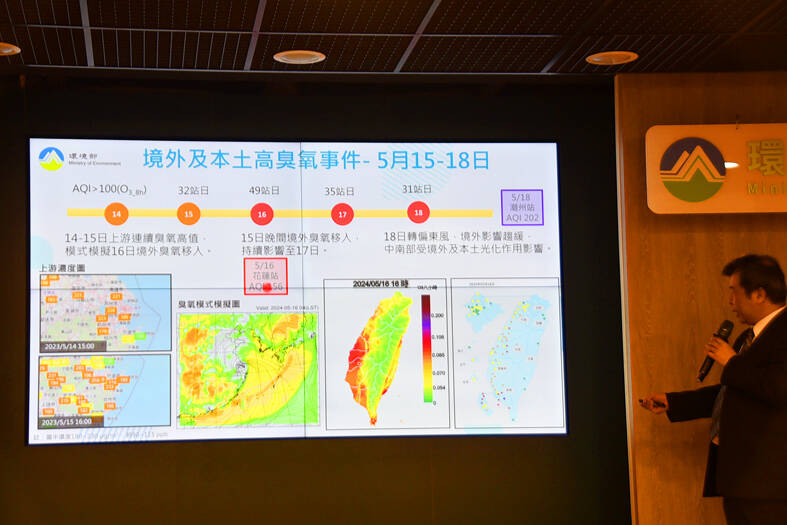The Ministry of Environment’s (MOENV) Air Quality Statistics issued on Thursday showed a general decrease in all pollutant density across the nation over the past five years.
Department of Monitoring and Information Deputy Secretary-General Hu Ming-hui (胡明輝) said statistics over the past five years showed that PM10, particulate matter 10 micrometers or less in diameter, have gone down by 8 percent, PM2.5 levels have fallen by 7 percent to 11 percent compared with last year, while nitrogen dioxide has gone down by 15 percent.
However, ozone pollution levels have only decreased by 3 percent, leaving much to be desired, Hu said.

Photo: Wu Po-hsuan, Taipei Times
Ninety percent of days in the five years had an Air Quality Index (AQI) level below 100, or were of average air quality, while weather stations only recorded 1,566 days during which the air quality was at “orange” — which is bad for those with allergies — down from 4,270 days in the five years to 2018, he said.
As of last month, the average PM2.5 density was 12.5mg per cubic meter, down from 13.7mg per cubic meter last year, the secretary-general added.
PM2.5 introduced from foreign sources in February coupled with this year’s Typhoon Usagi resulted in a spike in PM2.5 levels in Taiwan, Hu said.
The increased rain in the latter half of the year had helped reduce air pollution, Hu added.
Department of Atmospheric Environment Director-General Chang Shun-chin (張順欽) said NT$76.6 billion (US$2.34 billion) would be invested from this year to 2027 to decrease PM2.5 levels and ozone pollution.
The funds are to be used to target the petrochemical industry to reduce air pollution, lessen the number of high-emission vehicles by 50 percent, promote the use of electric-powered buses and environment-friendly joss paper, encourage ships to use coast-based power for recharging and restrict the residual amount of volatile organic compounds in commercial products, he said.
The new air quality standards, as defined under Paragraph 3, Article 5 of the Air Pollution Control Act (空氣污染防制法), that were amended in September are to enter into effect on Wednesday next week, Chang said.
The amendments would adjust the air pollution levels for the AQI, increasing the number of warnings issued, Chang added.
Air pollution forewarnings for outlying islands would be increased to three days of advanced warnings from one, allowing outlying islands to have more time to react to air pollution, he said.

Three Taiwanese airlines have prohibited passengers from packing Bluetooth earbuds and their charger cases in checked luggage. EVA Air and Uni Air said that Bluetooth earbuds and charger cases are categorized as portable electronic devices, which should be switched off if they are placed in checked luggage based on international aviation safety regulations. They must not be in standby or sleep mode. However, as charging would continue when earbuds are placed in the charger cases, which would contravene international aviation regulations, their cases must be carried as hand luggage, they said. Tigerair Taiwan said that earbud charger cases are equipped

UNILATERAL MOVES: Officials have raised concerns that Beijing could try to exert economic control over Kinmen in a key development plan next year The Civil Aviation Administration (CAA) yesterday said that China has so far failed to provide any information about a new airport expected to open next year that is less than 10km from a Taiwanese airport, raising flight safety concerns. Xiamen Xiangan International Airport is only about 3km at its closest point from the islands in Kinmen County — the scene of on-off fighting during the Cold War — and construction work can be seen and heard clearly from the Taiwan side. In a written statement sent to Reuters, the CAA said that airports close to each other need detailed advanced

Tropical Storm Fung-Wong would likely strengthen into a typhoon later today as it continues moving westward across the Pacific before heading in Taiwan’s direction next week, the Central Weather Administration (CWA) said. As of 8am, Fung-Wong was about 2,190km east-southeast of Cape Oluanpi (鵝鑾鼻), Taiwan’s southernmost point, moving westward at 25kph and possibly accelerating to 31kph, CWA data showed. The tropical storm is currently over waters east of the Philippines and still far from Taiwan, CWA forecaster Tseng Chao-cheng (曾昭誠) said, adding that it could likely strengthen into a typhoon later in the day. It is forecast to reach the South China Sea

WEATHER Typhoon forming: CWA A tropical depression is expected to form into a typhoon as early as today, the Central Weather Administration (CWA) said yesterday, adding that the storm’s path remains uncertain. Before the weekend, it would move toward the Philippines, the agency said. Some time around Monday next week, it might reach a turning point, either veering north toward waters east of Taiwan or continuing westward across the Philippines, the CWA said. Meanwhile, the eye of Typhoon Kalmaegi was 1,310km south-southeast of Oluanpi (鵝鑾鼻), Taiwan’s southernmost point, as of 2am yesterday, it said. The storm is forecast to move through central